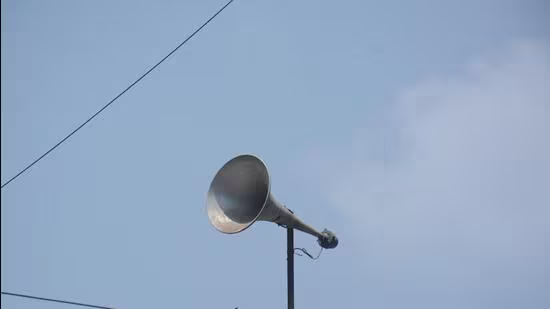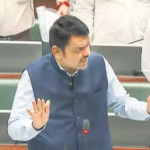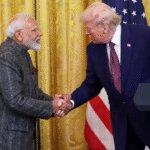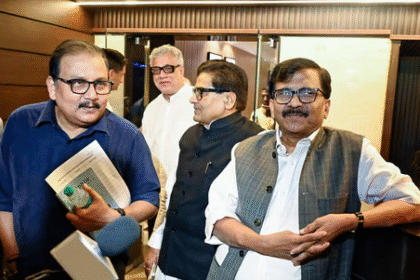No Religious Structure in Mumbai Uses Loudspeakers, Says CM Fadnavis
Mumbai, India’s bustling financial capital and a tapestry of religious diversity, has often found itself at the heart of national debates concerning faith, public space, and civic discipline. The city’s mosques, temples, churches, gurudwaras, and Jain derasars have long shared physical and auditory space in what is often described as India’s pluralism at work. But in a recent development, Maharashtra Deputy Chief Minister Devendra Fadnavis made a statement that is now reverberating through political and social circles alike: “Not a single religious structure in Mumbai has a loudspeaker today.”
At first glance, the announcement appears to be a matter-of-fact update on administrative compliance. But the significance of this statement lies not just in its factual claim, but in its broader implications—legal, political, communal, cultural, and constitutional. In an environment where loudspeakers atop places of worship have become a deeply polarizing issue, this claim invites analysis on multiple fronts.
In this long-form series, we will explore the historical context of loudspeaker usage in Indian religious practice, examine the legal landscape and court rulings that have shaped current policies, delve into the administrative mechanisms that enabled such compliance in a densely populated metropolis like Mumbai, and unpack the public reactions from different religious communities. We will also investigate the political motivations and timing behind the statement, especially in light of upcoming elections and the BJP’s narrative around “sound pollution” and “public order.”
The Loudspeaker Debate: A History of Noise and Rights
The use of loudspeakers in religious contexts is not a recent phenomenon. In India, amplification technology has been employed in public worship since the 1950s, when loudspeakers began appearing at major temples, mosques, and gurudwaras. What was once considered an enhancement to ritual became a routine fixture in the sonic identity of urban life.
However, this normalization began facing scrutiny in the 1990s, when courts started receiving public interest litigations (PILs) regarding noise pollution and its impact on health, especially in urban centers. The Supreme Court’s 2005 judgment (In Re: Noise Pollution – Implementation of the Laws for Restricting Use of Loudspeakers) marked a turning point. It placed a blanket restriction on the use of loudspeakers in public places between 10 PM and 6 AM and established decibel limits under the Noise Pollution (Regulation and Control) Rules, 2000.
These regulations were ostensibly religion-neutral, but in practice, they sparked political debates along religious lines. The issue of azaan (Islamic call to prayer) became especially charged, often singled out in political campaigns and media discourses. At the same time, many Hindu festivals—Ganesh Visarjan, Navratri, Dussehra—also breached permissible noise limits, yet enforcement was sporadic and uneven.
The Mumbai Context: Complexity Meets Enforcement
Mumbai, with its unique religious demography and dense population, presented both a challenge and a model. In this city of 20 million, over 3,000 registered places of worship coexist within a relatively compact space. The challenge wasn’t just legal—it was emotional, cultural, and infrastructural.
Over the past decade, several civic bodies, particularly the Brihanmumbai Municipal Corporation (BMC) and the Mumbai Police, initiated quiet yet steady enforcement measures. Notices were sent. Meetings were held with religious leaders across communities. Technical support was provided to measure noise levels and identify non-compliant installations.
What made the process effective, according to municipal sources, was the community-first approach. “It wasn’t about policing belief—it was about aligning practice with law,” said a senior BMC official who oversaw the joint task force on sound regulation. Religious boards were invited to cooperate, and many responded positively once they were assured that no faith was being targeted.
The result of these efforts, claims CM Fadnavis, is that Mumbai today stands as a rare Indian city where not a single religious site uses a loudspeaker for daily announcements or prayer—an outcome both administratively impressive and politically significant.
Devendra Fadnavis’ Statement: Timing and Intent
The Deputy Chief Minister’s statement did not come in a vacuum. It was made during a state assembly session in July 2025, at a time when the state government was under pressure to present its governance credentials ahead of the Maharashtra legislative elections scheduled for early 2026. The loudspeaker issue had surfaced intermittently in previous campaign cycles, often as a proxy for broader debates around religious assertiveness and state neutrality.
For Fadnavis and the Bharatiya Janata Party (BJP), the announcement serves multiple purposes. First, it signals administrative efficiency and “rule of law” governance. Second, it seeks to project a model of religious neutrality, where even Hindu temples—often presumed to enjoy institutional latitude—have complied. Third, it reinforces a narrative of modernity, where tradition is seen to yield to the needs of urban discipline.
Yet, critics argue that the announcement is not ideologically neutral. Civil society voices have pointed out that the issue has been selectively amplified in the past, often with communal overtones. “If the goal was public order, why focus on loudspeakers alone? What about hate speech on TV or in rallies?” asked a senior advocate from the Bombay High Court who specializes in constitutional law.
Public Response: Applause, Skepticism, and Silence
Public reaction to the announcement has been mixed. Among many residents, particularly in middle-class housing societies and senior citizen communities, the response has been one of relief. “We are able to sleep better, study better, work better,” said 73-year-old Minal Desai, a resident of Dadar. “It’s not about religion. It’s about decency.”
However, others have been more cautious. Some minority groups, especially from the Muslim community, have quietly complied with the removal of loudspeakers but remain uneasy about the optics of enforcement. “We were never told we couldn’t pray—we were told to lower the volume. But why is it always our microphone that becomes a headline?” questioned Abdul Mateen, a trustee at a prominent Mumbai mosque.
Interestingly, several Hindu temple boards have also raised concerns—albeit diplomatically. “If law is law, we follow it. But we hope the same enthusiasm is shown towards curbing noise during political rallies or construction projects,” said a member of the Siddhivinayak Temple Trust.
Conclusion: A Model or a Warning?
Fadnavis’ assertion that Mumbai’s religious sites have voluntarily complied with sound regulations is, if true, a notable feat in civic governance. It reflects a city willing to balance its rich spiritual heritage with the demands of modern urban life. But the implications of this achievement must be examined carefully.
Is Mumbai a model for peaceful regulatory implementation, or is it a case study in soft compulsion? Does the absence of religious loudspeakers indicate civic maturity, or does it mark the beginning of a more sanitized, state-defined spirituality?
The claim that not a single religious structure in Mumbai currently uses loudspeakers may seem sudden to some, but in reality, it is the result of a complex, years-long regulatory framework combined with intense administrative groundwork. While the optics of silence over prayer halls and temple towers may appeal to the ideal of urban order, it is essential to understand the machinery—legal, logistical, and cultural—that made this transition possible.
This transformation was neither dictated overnight nor enforced with brute power. Instead, it unfolded through calibrated coordination between the Maharashtra Police, Brihanmumbai Municipal Corporation (BMC), local religious committees, and the State Pollution Control Board. What began as a compliance issue gradually turned into a model of civic cooperation—albeit one layered with quiet pressure and political expectation.
Legal Framework: The Foundation of Enforcement
The legal basis for restricting loudspeakers originates from the Noise Pollution (Regulation and Control) Rules, 2000, issued under the Environment (Protection) Act, 1986. These rules strictly prohibit the use of loudspeakers or public address systems between 10 PM and 6 AM in any public or private place, with only rare exceptions allowed by district authorities under special circumstances.
Further judicial backing came through a landmark Supreme Court ruling in 2005, which upheld the rules and reiterated that the “right to silence” is part of the fundamental right to life and liberty under Article 21 of the Constitution. That judgment became the bedrock upon which all subsequent legal and administrative action on loudspeaker use has been justified.
In Maharashtra, the state government passed additional resolutions in 2017 and again in 2022, empowering District Collectors and Police Commissioners to identify and categorize all loudspeaker installations. They were instructed to issue notices to non-permitted structures and ensure removal within 15–30 days. After that deadline, enforcement was permitted, including dismantling the systems with police presence if necessary.
Mapping the City: From Survey to Shutdown
To implement this complex mandate in a city like Mumbai—home to over 3,000 registered places of worship across religions—required a detailed mapping exercise. Between 2022 and 2024, the Mumbai Police, in coordination with the BMC’s Environmental Engineering Cell, undertook a comprehensive city-wide survey. Teams visited each structure, measuring ambient decibel levels during peak hours of religious activity.
Structures found in violation were issued notices under the Bombay Police Act, 1951, and the Environmental Protection Act. The notices were structured with legal references, timelines for compliance, and warnings of possible criminal liability in case of defiance.
Senior police officials revealed that in over 80% of cases, structures voluntarily complied once served. The remaining 20% became negotiation zones. It is here that local religious leaders, MLA intermediaries, and police inspectors played a pivotal role—balancing faith with law.
Community Consultations: Dialogue over Dictate
The process wasn’t only legal; it was intensely human. Police officers held closed-door meetings with religious boards representing mosques, temples, churches, gurudwaras, and Jain derasars. The meetings emphasized two points: that the state sought compliance, not confrontation, and that all religious groups were being treated equally under the law.
To avoid allegations of bias, the Maharashtra government issued a uniform communication template, available in Marathi, Hindi, Urdu, and English. These letters clarified that the intent was not to curb religion but to protect public health and urban tranquility. The communications included scientific data on how excessive noise contributes to stress, anxiety, sleep disruption, and hypertension.
Significantly, several Muslim and Hindu religious leaders publicly endorsed the compliance move. “Islam does not mandate loudspeakers for azaan. It was a convenience of the 20th century, not a pillar of the faith,” said Maulana Azam Ali, a cleric from South Mumbai. Echoing this, Pandit Mahadev Joshi, head priest of a major temple in Thane, remarked, “God hears without amplifiers. What matters is sincerity, not volume.”
Enforcement with Empathy: The Mumbai Model
Despite the legal framework and community outreach, not every case went smoothly. In some areas—particularly in the northern suburbs of Mumbai—there were initial confrontations. A few mosques and temples resisted on the grounds that the rules infringed upon their religious rights. In these rare cases, local police made soft interventions first—holding dialogues, showing legal orders, and even requesting community elders to mediate.
Only in less than 2% of all surveyed cases did the authorities have to forcibly remove loudspeaker equipment. Even in those incidents, video footage was taken, written documentation preserved, and local press kept informed to avoid political misrepresentation.
The Mumbai Police Commissioner’s office also set up a helpline and an email address for citizens to report violations—but made it clear that the helpline was not for targeting religious groups, and that all complaints would be cross-verified before action.
Technology and Transparency
An underrated yet essential component of this drive was the use of technology to ensure transparency and accountability. A central Noise Compliance Dashboard was created, accessible to senior municipal officers and police commissioners. This dashboard mapped real-time complaints, resolved cases, pending notices, and decibel-level readings across wards.
In addition, the Maharashtra Pollution Control Board (MPCB) deployed mobile decibel monitors at major junctions near places of worship during peak hours. These monitors helped in both enforcement and public awareness. The data collected was used to prepare a report submitted to the state cabinet, which reportedly influenced the government’s decision to declare Mumbai as fully compliant in 2025.
Faith Without Noise: Shifting Cultural Norms
Perhaps the most remarkable transformation in Mumbai wasn’t just legal—it was cultural. Over time, as places of worship gradually phased out their loudspeakers, communities adapted. Morning prayers became quieter. Devotees turned to internal reflection. In some mosques, azaans were recited within the premises without any sound system. In temples, bhajans were conducted through low-volume indoor speakers or designated “sound hours.”
Younger citizens seemed particularly receptive. “We still pray, but we’re more conscious about others. That’s spiritual progress too,” said 22-year-old Radhika Iyer, a student in Andheri. Even in conservative neighborhoods, older citizens noted that less noise did not equal less devotion.
Of course, this transformation hasn’t occurred uniformly across the country. But Mumbai’s model shows that it is possible to align ancient traditions with modern civic realities—without provoking mass resistance, provided the process is inclusive, legal, and respectfully executed.
Echoes Across India: Politics, Replication, and Resistance
Maharashtra Deputy Chief Minister Devendra Fadnavis’ declaration that “not a single religious structure in Mumbai uses a loudspeaker” has reverberated beyond the boundaries of the city and the state. As the news gained national attention, it triggered a wave of discussion in political corridors, religious communities, and civil society organizations across India. The idea of regulating amplified religious sound—once considered too politically sensitive to touch—has now become part of a larger conversation about governance, law, and identity in Indian urban centers.
This part of the series focuses on how the “Mumbai model” is beginning to influence policy discourse in other Indian cities, how political actors are framing or opposing the issue for electoral gains, and how civil rights groups and secular watchdogs are responding to what they see as the selective application of legal principles.
The National Ripple: Other Cities Take Note
In the weeks following Fadnavis’ statement, urban policy planners and law enforcement authorities in major Indian cities such as Hyderabad, Lucknow, Bhopal, Ahmedabad, and Bengaluru have reportedly held internal meetings to evaluate whether Mumbai’s approach to regulating religious sound can be replicated in their jurisdictions.
In Hyderabad, a city that shares Mumbai’s demographic diversity and density, the Telangana police initiated a discreet audit of loudspeaker usage across religious places. Sources within the Hyderabad Police Department confirmed that notices have been issued to several institutions in violation of the prescribed decibel limits.
Meanwhile, in Lucknow, Uttar Pradesh Chief Minister Yogi Adityanath publicly applauded Mumbai’s compliance and referred to his government’s 2022 drive that removed thousands of unauthorised loudspeakers. However, civil society groups in UP were quick to point out the selective implementation and perceived communal tilt in the drive, with Muslim institutions reportedly bearing the brunt of enforcement.
Ahmedabad and Bhopal are following suit with policy reviews, though both governments have emphasized the need for “community consultation” before enforcement. Bengaluru has remained relatively silent, perhaps reflective of Karnataka’s newly elected Congress-led government taking a more cautious, centrist approach on polarizing issues.
Political Reaction: Polarization or Policy?
While the BJP has championed the move as an example of “equal law for all” and “good governance,” opposition parties have raised concerns about the political timing of Fadnavis’ statement. With the Maharashtra Assembly elections due in early 2026, and municipal polls in Mumbai scheduled for the end of this year, the issue of loudspeakers has taken on electoral overtones.
Leaders from the Congress, NCP (Sharad Pawar faction), and Shiv Sena (Uddhav Thackeray faction) have accused the BJP of weaponizing religious regulation to appeal to its core vote base. “This is not about noise. This is about narrative,” said former Chief Minister Uddhav Thackeray at a press briefing. “They want to portray one community as lawless and another as law-abiding. That’s dangerous.”
The All India Majlis-e-Ittehadul Muslimeen (AIMIM), a vocal opponent of loudspeaker crackdowns in the past, has also responded sharply. Party president Asaduddin Owaisi questioned the government’s priorities: “Where is this enthusiasm when it comes to hate speech, unemployment, or rising inflation? Religious audio is not India’s problem. Intolerance is.”
On the other hand, right-wing commentators and several national television anchors hailed Fadnavis’ announcement as a “watershed moment” in restoring civic discipline. TV debates erupted, hashtags trended, and editorials were published, all debating whether this marks the beginning of a “post-noise” India or a new wave of state overreach.
Civil Liberties Concerns: Between Law and Liberty
Amid the celebration and criticism, civil rights organizations have sounded the alarm about potential misuse and chilling effects of such regulatory moves. Groups like the People’s Union for Civil Liberties (PUCL), the Internet Freedom Foundation (IFF), and the Centre for Equity Studies (CES) have jointly issued statements urging a transparent, equitable, and constitutional approach to sound regulation.
Their concern is not with the removal of loudspeakers per se, but with the precedents being set. As one PUCL member remarked, “What begins as a technical compliance exercise could morph into a tool for suppressing minority expressions of faith or political dissent.”
Furthermore, rights groups are wary of the long-term legal implications. Could the Mumbai model be used to justify similar restrictions on public protest, street preaching, festival processions, or even amplified public rallies?
Legal experts also point to the need for judicial oversight. “Any policy that curtails expression—even ambient religious sound—must meet the constitutional test of proportionality,” said Advocate Asha Menon, a constitutional specialist based in Delhi. “Otherwise, we are just making obedience sound like virtue.”
Voices from the Margins: What Minorities Are Saying
The reaction among Mumbai’s diverse religious communities has been nuanced. In Part 2, we explored the official positions of prominent clerics and temple authorities. But beneath the surface of compliance lies a more complex emotional and cultural terrain.
For many Muslims, the azaan is not merely a call to prayer—it is an identity marker, a public affirmation of presence in a secular republic. The quiet removal of loudspeakers, even when voluntary, feels like a retreat from visibility.
Similar sentiments are found among some Christian and Sikh communities. “The church bell is our tradition, and we’re okay with reducing the volume. But there’s a difference between being consulted and being compelled,” said a pastor in Byculla.
On the other side, some secular-minded citizens and interfaith groups see the move as an opportunity to reclaim civic balance and cross-religious harmony. Organizations like Mumbai Interfaith Forum have begun holding joint community meetings, promoting silent spirituality and respect for public silence.
The Role of Media: Amplifying or Oversimplifying?
The role of the media in shaping the national response to Fadnavis’ announcement cannot be overlooked. While some outlets offered balanced reports contextualizing the administrative groundwork, many others turned the development into a binary political spectacle.
Primetime debates juxtaposed images of azaans with Supreme Court sound rules. Newspapers ran headlines focusing on “mosque compliance” while underreporting temple adaptations. The net effect was an impression—particularly outside Mumbai—that the law had disproportionately impacted Muslims, regardless of the actual balance of enforcement.
Social media further distorted the perception, with doctored videos, inflammatory posts, and unverified claims about police excesses going viral. Fact-checking organizations struggled to keep up, and once again, an issue that began as sound management risked becoming a flashpoint of religious polarization.
In a city like Mumbai, where the density of sound is as rich as its cultural history, the absence of loudspeakers from religious structures marks more than just administrative success. It signals a deeper and more layered transformation—one that touches upon ritual behavior, the acoustic character of a city, and the psychological experience of public faith.
Mumbai’s sonic identity has long been shaped by the intermingling of sacred sounds: the echo of azaan rising above rooftops, the rhythmic bells of aarti chiming from temples, the chorus of Sunday morning hymns spilling from churches, the waft of gurbani from gurudwaras, and the celebratory chants of Ganesh visarjan cutting across traffic. Together, these sounds created an audible map of the city’s religious diversity. With their collective reduction—or disappearance from amplification—the very soundscape of Mumbai is being redefined.
Sacred Decibels: How Ritual Adjusts to Regulation
Religious practice in India is often public in nature—not merely confined to spiritual interiors but also asserted, celebrated, and shared in communal space. This outward expression is woven into the city’s routine. Loudspeakers, once symbolic of this expression, served not only ritual purposes but also community signaling. A temple’s morning bell would awaken nearby residents, azaan would remind people of the prayer hour, and festival announcements served as invitations and warnings alike.
In the wake of new regulations, religious institutions have begun modifying their methods of worship and outreach. At several temples across Mumbai—such as those in Girgaon, Dadar, and Kandivali—the traditional aarti now plays through indoor, low-decibel audio systems confined within the sanctum. Devotees are encouraged to assemble in person rather than rely on distant audio cues.
At mosques, the muezzin’s call to prayer is still made five times a day, but increasingly within the prayer hall alone, without amplification. For many senior citizens, this shift is emotional. “For forty years, I’ve heard the morning azaan from my window. Today, there’s a silence that’s both peaceful and unsettling,” says Abdul Rehman, a retired schoolteacher in Mazgaon.
Churches and gurudwaras have similarly transitioned to indoor sound systems, limiting outward projection to special occasions. While some congregations welcomed the change—especially those located in residential areas—others reported a sense of disconnection from the city’s spiritual rhythm.
The Acoustic Soul of a City: What Are We Losing?
Urban planners and sociologists increasingly refer to the concept of “acoustic ecology”—a way to understand how the sounds of a city shape its emotional, social, and cultural experience. In this framework, sacred sounds are not just noise—they are markers of belonging, memory, and continuity.
For cities like Mumbai, this dimension is profound. The call of the conch shell at dawn in a South Mumbai temple, the harmonium accompanying bhajans in a Borivali mandir, or the collective chanting during Friday namaz outside Bandra’s mosques—these aren’t merely religious practices; they are part of the city’s daily soundtrack.
Now, as these sounds fade or retreat behind closed doors, urban acousticians ask: What replaces them? In most cases, the vacuum is filled with the mechanical—a rush of traffic, honking horns, the relentless whir of construction, the blare of advertisements, or the jingle of mobile ringtones. Some fear that in reducing “noise,” we may inadvertently be amplifying chaos of a different kind—sound that is commercial, anonymous, and often more disruptive.
Sound and Class: Who Gets to Be Heard?
An often overlooked aspect of this transformation is its class and privilege dimension. While upper-middle-class neighborhoods welcomed the sound regulation as a form of “civic discipline,” poorer communities—especially in informal settlements—have experienced the silencing differently.
In bastis and chawls, loudspeakers serve not only religious purposes but also community organizing tools. They announce deaths, births, school drives, and sanitation schedules. The azaan is often the only way for daily-wage earners to keep track of prayer times. In these spaces, the loudspeaker is not a luxury—it’s a lifeline.
Further, large processions like Ganpati Visarjan or Muharram—which occupy streets and use amplified sound—are often treated with leniency, either due to their scale or political patronage. This leads to the perception that sound regulation is not truly egalitarian, but targets the routine over the spectacular, the small over the loud, the everyday over the seasonal.
Sociologist Dr. Nandita Sinha puts it aptly: “We are not just asking who is making noise—we are deciding whose sound matters and whose doesn’t.”
Tradition vs. Modernity: The Dilemma of Devotion
This shift in religious expression also raises questions about the tension between tradition and modernity. India’s postcolonial journey has always involved the negotiation between ancient practices and evolving civic codes. The loudspeaker, a 20th-century addition to a millennia-old culture, ironically became a symbol of both progress and excess.
For many believers, turning off the loudspeaker is more than obeying the law—it feels like relinquishing visibility in the public square. At the same time, younger generations are more accepting of private, quieter devotion. They are more likely to stream aarti on YouTube, use apps for prayer reminders, or practice mindfulness over mass ritual.
Religious institutions themselves are adapting. Several temples and mosques have begun livestreaming prayers for devotees, thus maintaining access without sound leakage. This techno-spiritual compromise reflects a broader evolution of faith—one that may be quieter, but no less devout.
Does Silence Equal Secularism?
A critical philosophical question raised by this transition is whether silence is inherently secular. Can a city be more inclusive simply by making all religious expression inaudible? Or does that push diversity into the shadows, reducing public life to sanitized silence?
Some argue that managing sound is not the same as managing belief. A plural society doesn’t have to be mute—it has to be respectfully polyphonic. The problem lies not in sound itself, but in its monopolization—when one group’s faith expression drowns out another’s right to rest or think.
Others suggest that in hyper-saturated sound environments like Mumbai, controlled silence is an act of collective self-care. As urban stress and sleep disorders rise, reducing religious amplification is a small but meaningful step toward public health and civic empathy.
In either case, Mumbai’s transformation is not merely a governance story—it is a moral question about what kind of city we wish to inhabit. One where all are equally free to express, or one where all are equally silent.
Also Read : MSPSA Faces Fierce Backlash as Critics Vow Court Battles and Street Protests








